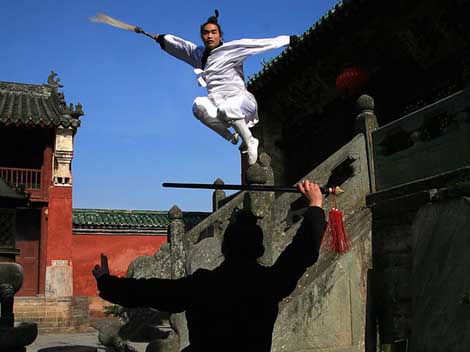| Home > China Feature |
Chinese Martial Arts, an Aspect of Chinese Culture

Chinese martial arts are an organic component of the Chinese culture. They reflect the entire Chinese cultural characteristics from one aspect.
Chinese martial arts have a long history, converging Chinese philosophy, medicine, military strategy, techniques, education, aesthetics, etc., and mirroring the character and sagacity of the Chinese people . The Chinese martial arts pay great attention to mental activities in fighting. They stress that mind should guide breath, breath should guide the motions of the body, that hands, eyes and pacing, spirit, breath and force, ferociousness and agility, the external and the internal, all should be coordinated , and that motions should be changeful and rhythmic. In addition, they tress winning through cunning and through taking advantage of the opponent's momentums, keeping the foothold firm, the waist nimble and the head safe. The martial arts practices do not mind to retreat a step first so as to be justified, advantageous and well controlled. The martial arts practices hit surely, accurately and forcefully, but put sureness in the first place.
The shaping of the Chinese martial arts results from three sources; philosophy and science, technical development and tutoring. The Chinese classic philosophy is the principle of the Chinese martial arts. The classic military stratagems are their contesting principles. The traditional medicine is their exercising principle. The technical development of the Chinese martial arts corresponds with the development of the classic culture and technique, particularly with the development of combating methods, artistic interests and hygiene. They underwent three phases. The first phase was the phase of bravery, based on strength and bravery; the second phase was the phase of martial skills, based on tactics and skills; the third phase is the phase of martial arts exercises based on standardization and stylization.
The course of the first phase involves blending ancient health preserving technique with fighting and grappling technique.
The course of the second phase involves typifying some fighting and grappling moves, and combining them with the art of dancing and acrobatics .
The course of the third phase involves combining body training with mind training, and adopting a set of "personality cultivating" technique to "coordinate body and mind".
The top concern of the Chinese martial arts is to settle the relationship between the body and the mind. They stress the "external exercises for bones and muscles and the internal exercises for breath" All the schools of martial arts stress "presence of mind, breath and strength", so as to equilibrate Yin & Yang, regulate breath and blood , smoothen channels and collaterals , and build up body and strength . They settle the relationship between "form and content" of martial arts by settling the relationship between mind and body and the relationship between oneself and his opponent. They all stress “changing according to different opponents”, and “getting opportunities through defending”.
The functions of the martial arts in fighting are : defending oneself against the opponent, checking the attacks and winning the fight. On the level of philosophy, the marital arts stress “unification of man and nature”, i.e. , the unification of existence and nonexistence, acting and stopping, Yin and Yang, mind and things, the subjective and objective, and the objective law and the subjective dynamism. On the social level, the martial arts stress cultivation of mind and personality, awareness of the natural law and complacency. They thus break all prejudices with regard to winning and losing and to successes and failures, and take a calm, “game” attitude. In fighting, the exercisers of the martial arts play calmly as in a game, with a free and initiative attitude. Therefore, the Chinese martial arts are not simply a sport event or a fighting technique, but are thinking, a style, life attitude and personality cultivation. In a contest with an opponent the Chinese martial arts exercisers not only take a great care about the moves, and exertion of force, but also take a great care about his own temperament and mind, with a martial arts spirit transcending mere technique.
Art
 more
moreChina Beijing International Diet ...
Recently, The hit CCTV documentary, A Bite of China, shown at 10:40 ...

Exhibition of Ancient Chinese Jad...
At least 8,000 years ago, Chinese ancestors discovered a beautiful...

Longmen Grottoes
The Longmen Grottoes, located near Luoyang, Henan Province, are a tr...

Custom
 more
moreWeb Dictionary
Martial Arts
Tai Chi Master Class Held in Moscow
MOSCOW, June 15, 2016 (Xinhua) -- Students learn from Shaolin ...
Celebriting 70 years' efforts in restoring Mogao...
Work is being carried out at the restoration site of cave No 98 a...
Hong Kong Children's Symphony performs in Seattle
Under the theme of Tribute to the Golden Age, a concert featuring a ...





 print
print  email
email  Favorite
Favorite  Transtlate
Transtlate 








